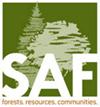北方阔叶林疏伐后反照率的变化
IF 1.5
4区 农林科学
Q2 FORESTRY
引用次数: 0
摘要
根据在新不伦瑞克省中西部进行的实地测定,建立了一个半经验模型,用于刺激北方耐寒阔叶林在砍伐后的季节性和盛夏反照率。在该模型中,反照率的变化与以下因素有关:(1) 植被的重新生长(新长出的叶子铺满砍伐区域);(2) 林冠内植被层的逐渐增加;(3) 从萌芽到秋季的季节性变化。实地数据表明:(1) 砍伐降低了反照率;(2) 在砍伐作业后的几年内,叶片重新生长使反照率迅速增加到最大值,类似于连续单叶层的反照率;(3) 树冠层加深使反照率在达到最初的峰值后逐渐降低;(4) 除砍伐作业后的第一年外,反照率值在初夏最高。For.科学》41(2):268-277。本文章由计算机程序翻译,如有差异,请以英文原文为准。
Changes in Albedo of a Northern Hardwood Forest Following Clearcutting
A semi-empirical model designed to stimulate seasonal and midsummer albedo of a northern tolerant hardwood stand following clearcutting was developed from field determinations conducted in west-central New Brunswick. In this model, changes in albedo are related to (1) vegetative regrowth (spreading of newly developing foliage over the cut area); (2) the gradual addition of vegetation layers within the forest canopy; and (3) seasonal variations from bud burst to fall. The field data indicated that (1) cutting reduced the albedo; (2) foliage regrowth rapidly increased the albedo to a maximum similar to that of a continuous single leaf layer within a few years after the cutting operation; (3) deepening of the canopy gradually decreased the albedo after its initial peak; and (4) albedo values were highest in early summer, except in the first year after the cutting operation. For. Sci. 41(2):268-277.
求助全文
通过发布文献求助,成功后即可免费获取论文全文。
去求助
来源期刊

Forest Science
农林科学-林学
CiteScore
2.80
自引率
7.10%
发文量
45
审稿时长
3 months
期刊介绍:
Forest Science is a peer-reviewed journal publishing fundamental and applied research that explores all aspects of natural and social sciences as they apply to the function and management of the forested ecosystems of the world. Topics include silviculture, forest management, biometrics, economics, entomology & pathology, fire & fuels management, forest ecology, genetics & tree improvement, geospatial technologies, harvesting & utilization, landscape ecology, operations research, forest policy, physiology, recreation, social sciences, soils & hydrology, and wildlife management.
Forest Science is published bimonthly in February, April, June, August, October, and December.
 求助内容:
求助内容: 应助结果提醒方式:
应助结果提醒方式:


